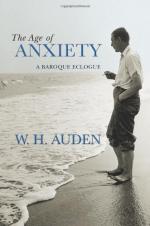|
This section contains 1,779 words (approx. 6 pages at 300 words per page) |

|
The first of Auden's longer works, Paid on Both Sides: A Charade,… is ostensibly an episode in a continuing feud between two families who live some fifteen miles apart in the Lead Dales of the English north country…. (p. 287)
Auden seems to have intended the charade as a vehicle for an ambitious allegory on the life and death instincts—a modern Morality of Eros and Thanatos—that could take its place beside Eliot's The Waste Land…. Paid on Both Sides is a variation on the Orpheus myth that Auden was to employ again with Marxist overtones in his next dramatic work, The Dance of Death (1933)…. (p. 288)
Although it is Freud who supplies the underlying theme of Eros and Thanatos as instinctive energies of the libido, much of the substance of Paid on Both Sides is derived from C. G. Jung's Wandlungen und Symbole der Libido (1912), a work now...
|
This section contains 1,779 words (approx. 6 pages at 300 words per page) |

|


